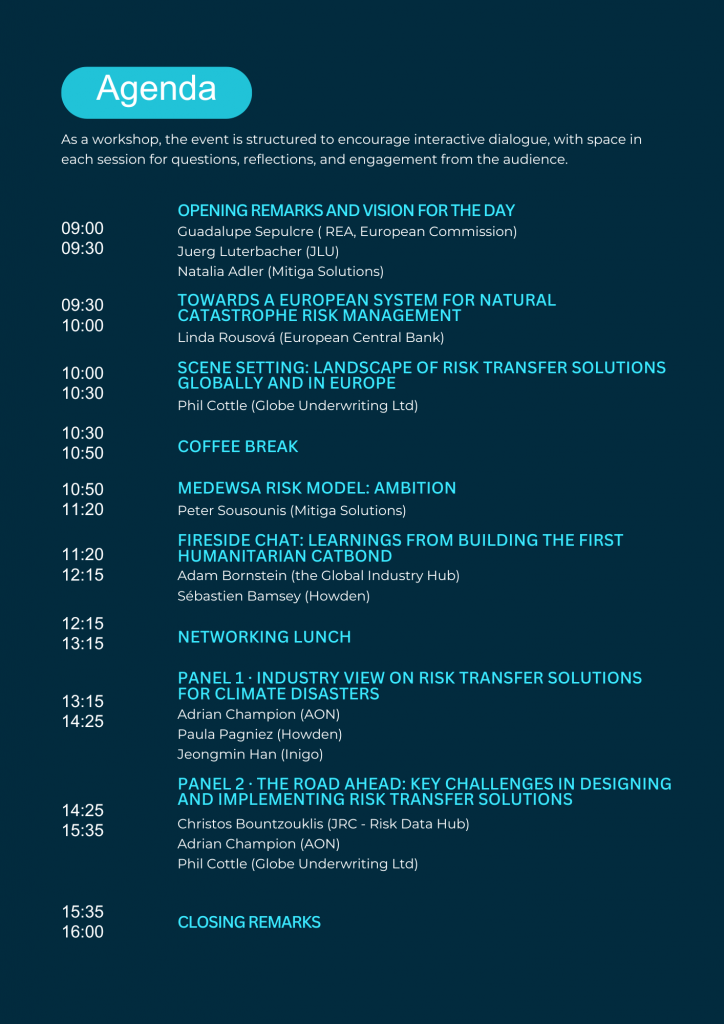📍 Venue: Permanent Representation of the Slovak Republic to the EU | Avenue de Cortenbergh 79, 1000 Brussels
🕘 Date: Tuesday, 24 June 2025 9:00 – 16:00
⏳ Deadline extended till 21st June 2025

Project and Workshop Overview
The MedEWSa project aims to couple cutting-edge extreme weather forecasts, as part of an early warning system, with innovative risk transfer solutions, such as parametric insurance and forecast-based financing (FbF), to effect rapid recovery from climate disasters for regions across Europe, the Mediterranean, and Africa.
The purpose of the workshop is to collect input for making actionable decisions on specific risk transfer solutions depending on the peril and the region from stakeholders with a vested interest in facilitating such recovery. The workshop is a unique opportunity for stakeholders to collaborate on climate adaptation finance, ensuring sustainable economic resilience in the face of increasing climate-related disasters.
Who Should Attend?
- Policy Makers & EU Institutions (DG-ECHO, DG-REGIO, DG-FISMA, DG-CLIMA, ECB)
- (Re)Insurers & Brokers
- Government Representatives (disaster-prone regions such as Greece, Slovakia, and Sweden)
- Financial Institutions & Investors
- Crisis Managers & Emergency Responders
- Technology & Infrastructure Experts
- Academia & Research Institutions
Why Should You Attend?
- Share your knowledge (e.g., experience with disaster recovery from humanitarian, economics perspectives) and experience in risk transfer solutions.
- Explore opportunities to co-design risk transfer solutions for climate disasters in Europe and Africa.
- Learn more about MedEWSa (e.g., climate hazards, specific regions, proposed solutions) and contribute to the development of the project’s risk transfer platform.
Workshop Information
The workshop will take place on 24.6.2025 at the Permanent Representation of the Slovak Republic to the EU, Avenue de Cortenbergh 79, 1000 Brussels. All participants’ IDs will be checked upon arrival.
Due to the hands-on and participative approach of the event, the attendance is limited to 50 spots. Registration will close on the 21 June 2025, 17:00 CEST
Key Topics & Expected Outcomes
- Exploring existing risk transfer mechanisms (successes and challenges).
- Understand catastrophe bonds & insurance mechanisms to close financial protection gaps.
- Integrate Early Warning Systems (EWS) with financial instruments to enable rapid response and recovery.
- Assess economic impacts & insurance affordability in disaster-prone regions.
- Develop actionable strategies for financial resilience and risk-sharing models.
Background: A very brief intro to alternative risk transfer solutions
While EWS focuses on minimising physical harm and protecting lives by enabling preventive actions, insurance policies can help address the financial aftermath, compensating for damage and aiding recovery. Together, these systems complement each other, with EWS reducing potential losses and insurance providing financial support for recovery, creating a more resilient approach to disaster management.
Insurance policies work by assessing the risk of a potential event based on factors such as the probability of occurrence, the vulnerability of the insured party, potential damage, and the actual losses if the event happens. The insurer calculates premiums based on these risk factors, and if the insured experiences a covered event, the policy compensates for the damage or loss.
Traditional insurance, known as indemnity insurance, operates by reimbursing the policyholder for the quantified value of the loss. This often requires a detailed assessment of the event’s financial impact, such as the cost of repairs or replacing assets. While this ensures precise compensation, it can be time-consuming and may delay financial relief when it’s urgently needed, such as after a natural disaster.
In contrast, parametric insurance (or non-indemnity insurance) offers a more streamlined approach, where payouts are predetermined and triggered by specific event thresholds, such as rainfall levels or wind speed, without the need for loss assessments. This allows for faster disbursement of funds, which is especially critical in disaster-prone regions where immediate access to financial resources can significantly impact recovery. Thus, while indemnity insurance provides comprehensive coverage for actual losses, parametric insurance emphasises speed and efficiency in disaster recovery. Parametric insurance offers faster payouts, often within weeks, and greater flexibility in terms and structure, including multi-year contracts.
What is the main goal of the workshop? What are the expected outcomes?
The goal of this workshop is to identify the best risk transfer solutions for different regions and perils (whether they have a precedent or not). Participants of the workshop will acquire a common vocabulary on the subject matter and how to structure risk transfer solutions.
The main outcomes from the workshop include:
- Better understanding of climate adaptation opportunities: Innovative risk transfer solutions like cat bonds align with climate adaptation by enabling proactive financial planning, promoting resilience, and ensuring recovery resources are available in the face of increasing climate-related risks. They not only protect against immediate impacts but also support the systemic changes needed to adapt to a changing climate.
- Risk Management improvement: Participation in discussions about innovative risk transfer solutions could enable better assessment of how financial institutions can protect themselves against climate-related risks, strengthening the resilience of the banking sector. Concretely, catastrophe bonds help ensure that climate related financial risks are diversified across global markets, reducing the risk that banks in affected regions face overwhelming financial strain. From the risk management perspective in climate-vulnerable areas, the workshop would provide insights to help better understand the mitigation potential of regional financial risks and maintain consistent monetary policy transmission across member states.
Better understanding of implications for financial stability: Climate disasters can severely impact economies, disrupting financial markets, insurance sectors, and overall economic stability. Gaining a deeper understanding of how innovative risk transfer mechanisms (such as insurance and reinsurance) can mitigate these economic disruptions is essential for informed policy decisions. The workshop would provide insights into innovative risk transfer solutions, which are becoming critical to reduce the potential for systemic shocks within the financial sector and to minimise the spillover effects that could destabilise banks exposed to such insurers.







